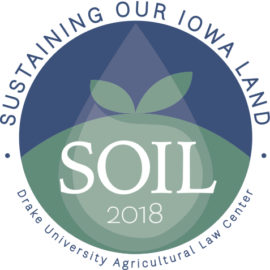Updated on May 24, 2018
ALC to Issue Guide for Farmers and Landowners on Navigating Public Programs to Improve Water Quality
The Drake University Agricultural Law Center will release a new report “How to Improve Water Quality on Iowa Farms: A Step-by-Step Guide for Navigating Conservation Programs for Farmers and Landowners” next week. The 65-page report will be available for download from the Center’s web site at http://aglawcenter.wp.drake.edu/research/.
“Our goal is to make it easier for Iowa farmers and landowners to understand the public cost-sharing programs available to protect our soil and water,” said Professor Neil Hamilton, director of the Center. The Guide was developed under a 2017 grant from the Leopold Center at Iowa State University, which is now coordinated by the Iowa Nutrient Center.
Matt Russell, who helped create the Guide in his role as the Resilient Agriculture Coordinator with Drake, noted, “Iowa has a wide range of programs to assist those interested in putting conservation on the land, but being able to understand who administers the programs and the process for applying can be confusing.”
The Guide examines the programs in two ways: first, the discussion describes various conservation and water quality practices available—such as cover crops or installing grass waterway—and lists which federal or state agencies have financial assistance programs that can help support each practice. Secondly, the report takes a detailed look at federal and state conservation and water quality programs to explain how they actually work for interested farmers and landowners.
Popular federal efforts such as the Conservation Stewardship Program (CSP), the Environmental Quality Incentives Program (EQIP) and the Conservation Reserve Program (CRP) are explained in detail. Similarly, various state cost sharing programs such as the Water Quality Initiative, Financial Incentive Program for Soil Erosion Control, and the Iowa conservation practices revolving fund are explained, including how they are administered. The Guide uniquely features a set of common questions for each program, including who is eligible, how one applies, what documents are required, how selections are made, how practices are implemented, how payments happen, and how programs are enforced.
“If we expect farmers and landowners to use public programs to protect soil and water, we feel it is important to take the mystery out of how to actually apply to use them,” Hamilton said.
The Guide explains how many programs are delivered through the county Soil and Water Conservation Districts. It gives suggestions for working with the districts, especially the value of developing a personal relationship with the conservation professionals so an effective plan can be developed for a farm.
The final section of the Guide covers Private Conservation Initiatives. These are typically programs where a private business involved with food or agriculture works with farmers to implement a soil or water conservation project. The Guide is one of the first efforts to evaluate and discuss the potential these programs may have for providing additional support for soil and water conservation. A case study of how one Iowa farm is using both public and private programs to improve soil health and water quality is used to demonstrate this potential.
For more information and to find other resources for farmers and landowners, visit http://aglawcenter.wp.drake.edu/research/



